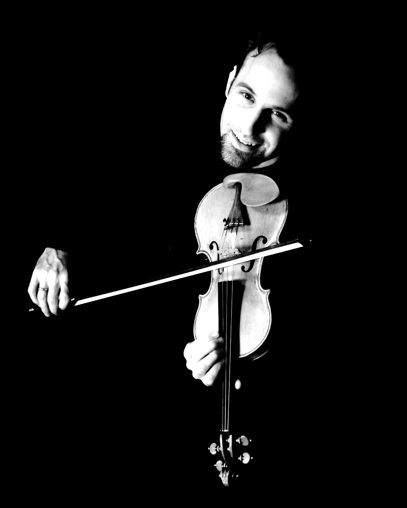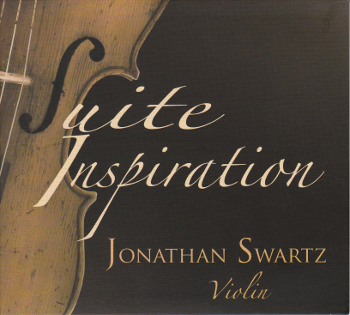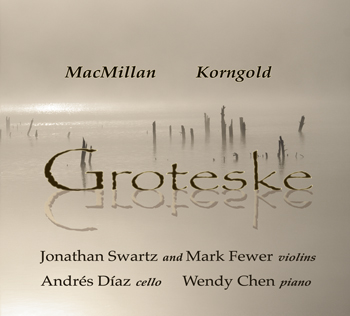
Fine Classical, Instrumental, and Specialty Recordings
Label: Soundset Recordings Item Number: SR1039 Format: CD Year Recorded: 2011 Suite Inspiration Jonathan Swartz
Jonathan Swartz - Violin  A native of Toronto, Jonathan Swartz has distinguished himself throughout North America both as a performer and pedagogue. While serving on the faculties at Arizona State University, the Rocky Mountain Summer Conservatory, and the Domaine Forget Academy, Mr. Swartz has maintained a prolific performing career. He has appeared at the Smithsonian Chamber Music Society, Colorado"™s Strings in the Mountains Chamber Festival, the Ottawa International Chamber Music Festival, the Mooredale Concert Series, and the Artists Series at Roy Thompson Hall, in addition to several venues under the auspices of Les Jeunesses Mu¬sicales du Canada. He is also a member of the Iris Orchestra under conductor Michael Stern, an ensemble that regularly performs with the world"™s leading artists. Sought after as a master clinician, and frequent presenter at the American String Teachers"™ Association National Conferences, Mr. Swartz was interviewed by STRINGS magazine for an article in the October 2006 issue regarding his approach to bow technique. He has given master classes throughout North America, and has previously served on the faculties at the University of Texas at El Paso, the Interlochen Arts Camp, and the Innsbrook Institute. Mr. Swartz is the founder and Artistic Director of the Visiting Quartet Residency Program at Arizona State University, a chamber music program that integrates visiting resident artists with a comprehensive chamber music curriculum. Quartets in this residency have included the St. Lawrence, Juilliard, Brentano, Tokyo, and Orion String Quartets. Mr. Swartz is also co-founder of the Violinists"™ Seminar at Le Domaine Forget - a team-taught intensive training program for advanced violinists. Mr. Swartz earned a Bachelor of Music cum laude from Rice University, a Master of Music from the Mannes College of Music, and a Doctor of Musical Arts from Rice University. His doctoral thesis is "Perspectives of Violin Pedagogy: A Study of the Treatises of Francesco Geminiani, Pierre Baillot, and Ivan Galamian, and a Working Manual by Jonathan Swartz." For further information, visit jonathan-swartz.com Suite Inspiration . . . How curious is the genesis of creativity, the inspiration from which a work of art is born. Was it a person, place or thing that planted the seed, a performer or perhaps another work of art? Many have wondered about Bach's inspiration to write his Sonatas and Partitas for unaccompanied violin, BWV 1001-1006. Some have thought that they were written as studies for the violin, while others find it hard to believe these inspired works were conceived for such a pragmatic purpose. There are no definitive sources to answer this question, although one of the most plausible accounts points to the great German violinist of Bach's time, Johann Georg Pisendel. Bach and Pisendel crossed paths in Dresden, in 1717, and it is believed that Pisendel presented his Sonata in A Minor for unaccompanied violin to Bach at that time. This may have provided Bach the incentive, as well as the performer for his unaccompanied violin works. A deeper look at both Bach's and Pisendel's compositions lends credence to their possible connection. Pisendel's final movement is a Giga and Variationen, certainly a precursor if not a direct model for Bach to emulate. Bach wrote dance movements and variations in his Partita No. 1 in B Minor, each dance paired with a Double that embellished the same harmonic progression. A Giga and Variationen could also be seen as inspiration for Bach's Chaconne, a dance with a repeated harmonic progression serving as the basis for a set of variations. The inspiration for Kieren MacMillan's Chaconne and Suite No. 1 has an unmistakable origin. Commissioned by me in 2000 and 2003 respectively, they clearly were influenced by Bach and, in particular, his Partita No. 2. They also seem as though they could have found inspiration in Pisendel too, although Pisendel's compositions were not known to either of us at the time. My decision to commission Kieren over other composers rests in part from having witnessed firsthand the manner in which he appreciated and adored great works of the past, and how these influences manifested themselves in his unique compositional voice. He is an artist whose creativity needs to be celebrated. I am pleased to present his new works alongside such historical masterpieces. Jonathan Swartz Pisendel Sonata in A Minor Johann Georg Pisendel had compositions dedicated to him by Georg Philipp Telemann, Tomaso Albinoni, and Antonio Vivaldi. His mastery of the instrument can be traced to Italian influences, having studied at different times with Guiseppe Toreli and Vivaldi. This influence is evident in his Sonata in A Minor, which contains great technical demands. This sonata begins with a slow movement, reflecting the rhetorical style characteristic of the Baroque. One can imagine a narrative punctuated with dissonances that pose questions. The second movement is lively and seems to confidently examine the "questions" of the previous movement, balancing the initial movement in the way a fugue might balance a prelude. The final movement, Giga and Variationen, completes the sonata with a dance and an ornamented disguise. This substantial movement can be seen as a precursor to Bach's Chaconne, and serves similarly to add meaning to the sonata as a whole. Bach Partita No. 2 in D Minor Bach's Sonatas and Partitas for unaccompanied violin were composed ca. 1720 while Bach was serving as Kapellmeister at the court of Prince Leopold of C�then, a period from which most of his secular instrumental works originate. The Partita No. 2 has become a benchmark in violin study and performance today, largely because of its final movement, an undisputed masterpiece, the Chaconne. All of the movements in this partita are dances. The Allemande begins the partita in a processional manner, and it is followed immediately, as instructed by Bach ("Segue a la Corrente"), with the running-paced Corrente. The Sarabande follows in a calming manner, serving as an emotional center for the entire partita. This is followed by the Giga, with galloping energy to balance the Sarabande. It is no coincidence that the final movement, Chaconne, shares its dance rhythm and pacing with the Sarabande, bringing back this emotional center for deeper contemplation and a grandeur that has made this movement one of the most identifiable works in all of the Baroque. Performers today are presented with many considerations of how to approach this music. One can argue that it transcends time and can be performed and appreciated regardless of historical correctness. Others will posit that it is only appropriate to perform it as Bach must have heard it, with stylistic and period considerations that include using period instruments and tuning. The choice here was to present this music informed by historical stylistic considerations, but with our modern instrument, would not choose to take advantage of the sound and potential of our modern instruments if he lived today. Violinists might note that many of my choices were made to honor Bach's manuscript, in particular the groupings of slurs, which I believe are indicated by both his handwriting and harmonic implications. MacMillan Chaconne As a musical form, the chaconne has been around for at least five centuries. Chaconnes have been written for everything from solo instruments to full orchestra, by composers from John Blow to John Adams. An entire ballet choreographed by Balanchine took its inspiration from a single chaconne in an opera by Gluck. What is it about this form that has proven so compelling, so timeless, so fertile a creative soil? It doesn't hurt that the chaconne is an inherently interesting musical structure: it guarantees unity through the repetition of a single harmonic progression, while ensuring diversity through continuous variation and embellishment. Like a good Cubist painting, a chaconne unveils its subject gradually to the listener, each new perspective revealing previously unknown and surprising views of increasingly familiar material. But perhaps more importantly, the chaconne is a rigorous and well-defined structure. To paraphrase Stravinsky: the more restrictions one puts in place, the freer one can become in the creative details. Having chosen to write a chaconne, the composer � now unencumbered by concerns about form � is free to fill that old bottle with whatever new wine he wishes. My Chaconne consists of a series of thirteen embellishments over a basic harmonic progression, framed by twin statements of the principal material. Not surprisingly, the piece owes a great deal to the example set by Bach's famous Chaconne in d minor: each variation includes a double statement of the harmonic progression; the sarabande rhythm, which stresses the second part of each measure, features prominently; and the progression undergoes an unexpected modal adjustment midway through the piece. The musical language I used is, of course, somewhat different from Bach's, mine being infused with the jazz and film score harmonies that formed much of the soundtrack of my life at the time. MacMillan Suite No. 1 About two years after the premiere of the Chaconne, Jonathan commissioned a second unaccompanied violin piece. (I considered it very high praise at the time, and still do to this day.) We decided that a suite of short dance movements in a neo-Baroque style would be a good companion for the Chaconne. To provide some contrast, I chose to avoid the multiply-stopped chords and highly contrapuntal texture that characterized the Chaconne, and wrote instead in a more linear and florid melodic style. This decision is evident from the very beginning of the Introduction, which opens with an arching, rolling gesture outlining the harmonic progression on which each movement is built. With very few exceptions - primarily at cadences, or as special effects - this more lyrical approach remains dominant throughout the piece. Naturally, this Suite was influenced by Bach's solo violin and cello works, which I knew and loved. It was also profoundly informed by my own experiences playing dance suites as a pianist: for example, the inclusion of a Loure is a nod to my piano teacher, Brian Connelly, with whom I had the distinct pleasure of studying Bach's fifth French Suite.
Label: Soundset Recordings Item Number: SR1039 Format: CD Year Recorded: 2011 Virtuoso music for unaccompanied violin performed by Jonathan Swartz, featuring works by Johann Georg Pisendel, Johann Sebastian Bach, and Kieren MacMillan. CD Review: Jonathan Swartz finds beguiling Bach voice with his violin -MARCH 27, 2012, Musical Toronto, John Terauds This month's trilogy of fascinating new recordings of music by J.S. Bach includes Toronto native Jonathan Swartz's beguiling interpretation of the Partita No. 2 for solo violin. (For a review of David Jalbert's recording of the Goldberg Variations and Lara St. John's Bach Sonatas, click here.) Swartz sounds as if his bow were strung with threads of silk rather than horsehair. This is especially difficult to achieve with solo violin pieces, because the performer has to separate the notes on the score into melody and accompaniment or, at the very least, a dialogue between two or more voices - all of which have to come from the same bow. The full beauty of Swartz's work becomes clear in the long, closing Chaconne in the Bach Partita, where the violinist sustains a palpable musical arc, complete with delicate counterpoint, over 16 minutes. It's something to treasure. Swartz, who has been based in Arizona for several years, but makes regular visits to Canada, has complemented this album with a tidy unaccompanied Sonata by Bach contemporary, master violinist Johann Georg Pisendel (1687-1755), as well as a new suite, and a Chaconne, both clearly inspired by Bach'sPartitas, by Toronto-based composer Kieren MacMillan. Coming after the Bach, MacMillan's Suite No. 1 sounds a bit anonymous. It is loosely based on a Baroque dance suite, containing five movements, but the styles of each movement could use a bit more differentiation. The "Exit Music" finale sounds as if the violinist absent-mindedly wandered off before finishing the suite. | 
Physical CD $15.99 US
| ||||||||||||||||||||||||||||||||||||||||||||||||||||||||||||||||||||||||||
 Amazon
Amazon
 Follow Us on Twitter
Follow Us on Twitter Follow Us on Instagram
Follow Us on Instagram Visit Our Partner Soundset Recordings
Visit Our Partner Soundset Recordings